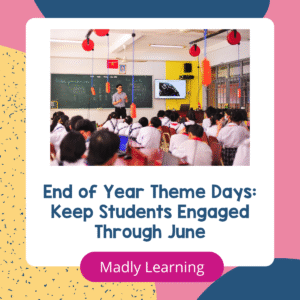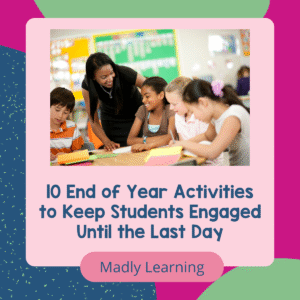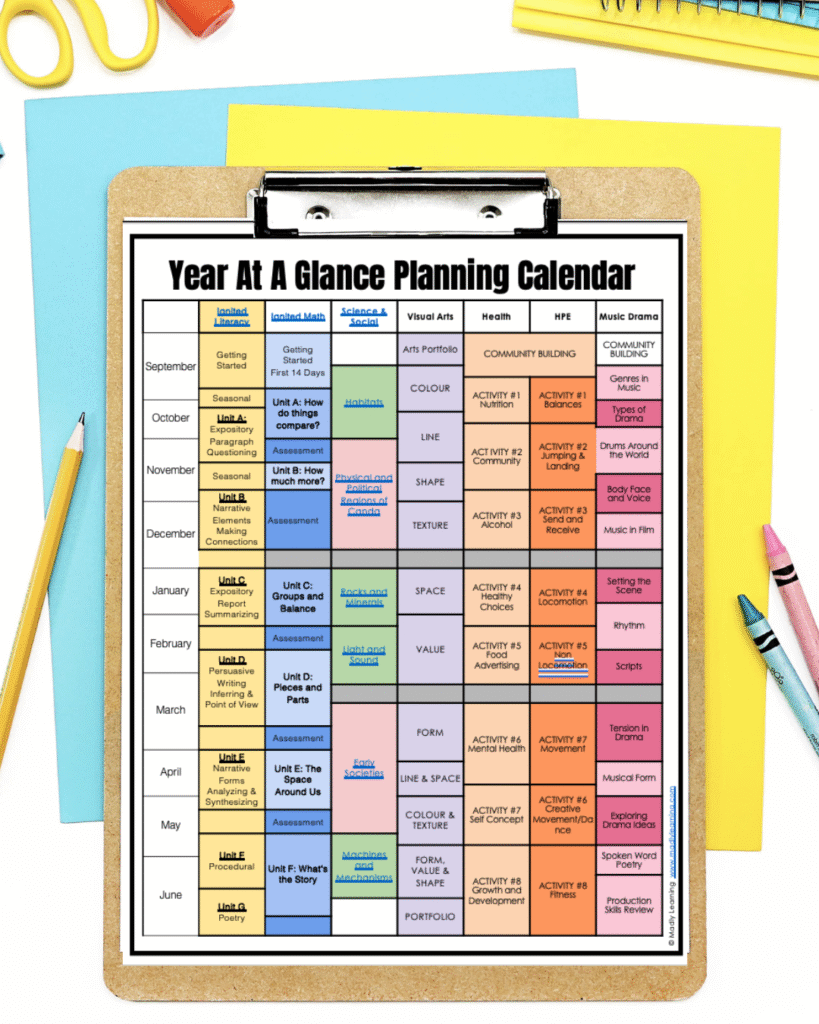So you have 100 minutes, but how exactly do you plan and schedule your language arts block for the junior grades?
Every day I am given between 80 to 100 minutes of uninterrupted language arts time in my schedule.
In that time I must plan out how to get everything done. My goal is to plan all of my lessons so that they flow together and fit, not so that they are a disjointed mess of “LET’S CRAM IT ALL IN”
Instead I like to organize my literacy activities so that everything flows and supports the learning from one task to the next.
One of the things that I am asked most by new and old teachers is how do I plan and schedule my language block so that it makes sense and is not a planning nightmare. Especially in 2024 with new curriculums and a focus on the science of reading and structured literacy for junior students.
If you haven’t already read how I set up my physical classroom space for literacy instruction check out my previous post here
What does my Literacy Block Include
It’s no wonder teachers struggle with how to fit everything in. There is a lot that needs to be covered in a week.
- Read Alouds
- Shared Reading
- Student Conferences
- Independent Reading Responses
- Creative Writing/Writers Workshop
- Grammar
- Spelling and Morphology
- Reading Mini Lessons
- Writing Mini Lessons
- Guided Instruction
Yes all of these things are included in my language arts time. However, not everything happens in one day. I take a whole week to make sure that I do these things.
How to Plan and Schedule Your Language Arts Block

The first step to crafting your plan is to evaluate how much time you have. If you have 100 minutes in your block then you can follow the timings in the guide
10 Minutes – Warm Up
25 Minutes – Lesson
15 Minutes – Student Center and Guided Reading
25 Minutes – Lesson
15 Minutes – Student Center and Student Teacher Writing Conference
10 Minutes – Consolidation or Novel Read Aloud Time
Now these timings are just guidelines and are easily adjusted.
If your students need more or less time for centers then adjust the time of the other areas such as your warm up and your teacher lessons.
There have even been years that I have used my warm up as my first center so we don’t have a warm up time. This is what I had to do last year because I only had 60-80 minutes for literacy a day. This means I do the same activities but just in a different order. If you have a reduced schedule or limited time check our my post on how to plan your 60 minute math block.
Remember this is your IDEAL SCHEDULE and that reality might mean it looks different. Give yourself grace, you might not get to guided reading every day – that’s okay.
Parts of your Schedule
Make your plan and schedule for language arts as routine and repeatable as possible. Even if the tasks you do are different each day the routine and structure you follow remains the same. This will be a huge help regarding classroom management. Students need predictability and organization so make thes as familiar as possible.
As for what you do when each week, there are a few different types of activities you should include.
Warm Ups
This can include lots of different types of activities. For me, this is a huge transition time and I need this to be independent. Sometimes I simply do independent reading, I also used a reflection journal, creative writing or other independent work from another subject. What I choose is what works best for the group of kids in my classroom. This allows me to set the tone, and mood for my language block.
Teacher Directed Lessons
These are whole group lessons where you model various skills related to literacy. Throughout the week you can engage in a variety of activities
engage in a variety of activities
- Spelling and Morphology: In a junior classroom (3-6) it is important that there are some explicit lessons regarding spelling rules and patterns, phonics, and morphology. These are systematic and explicitly taught. These are easily interwoven into lessons attached to shared reading and vocabulary building. I use the Ignited Spelling component of my Ignited Literacy program to teach a new skill each week and embed this practice within our shared reading text and vocabulary building. These initial spelling lessons, work to build understanding ofthe spelling skill through inquiry and wonder, then review the rule or pattern in a specific sequence.
- Shared Reading and Vocabulary: Next we apply our spelling rule and pattern into a shared reading activity. I strategically use the texts in Ignited Spelling that are filled with examples of the spelling pattern to notice and note the rule or pattern in context. From here we use this text again to learn new vocabulary words and look at text patterns and features.
- Read Alouds: I use picture books as model mentor texts to build skills of comprehension, reading fluency. I try to pick books that act as windows, doors and prism for my students so they see themselves represented in what we are reading or to reflect experiences and words in which they are not familiar. I use picture books over read alouds because it provides me a much simpler model for looking at writing forms, and allows me to select a much more diverse group of texts to use with students.

- Text Analysis and Reading Comprehension: I use the read aloud as a jumping off point to teach various ways students can demonstrate their understanding, comprehension and analysis of what they read. These are explictly modeled and students begin to practice these skills during independent practice.
Writing Form, Process and Style: Next I create writing lessons that teach students a specific skill. These lessons relate to the writing process steps students are developing skills in, they are introducing them to specific elements of writing forms or analyzing elements of writing style.
Plan and Schedule Your Language Arts Student Centers
A big part of your language arts is your student independent work. Each week students engage in different centers activities to practice various skills
- Reading Comprehension: Students complete various reading comprehension activities that are related to the focus of the week that was taught or is being taught during whole group lessons. I always want students to practice this skills and learn and develop these skills as they go. So even if I haven’t taught them every element I still like them to try and practice. I always remember that I am not teaching a group of blank slates, I know that students have previous experiences and skills that they developed in other teacher’s classrooms and it is important for them to draw on this previous experience and combine it what what new skills I am teaching.
- Writers Workshop/Creative Writing: Students need to write every day! so I make sure that every day they get a change to write. Now here is where I might do things differently. I don’t tell them what they have to write. I let them choose. Sometimes they write me a story and other times they write me about something they know (report). Then I meet them where they are, and we work during conferences to improve and develop their writing skills. In the last 10 years of teaching this way, I have found I develop much more confident writers who
- Spelling and Vocabulary: Students will apply the skill they learned at the beginning of the week and apply their learning to their weekly spelling and vocabulary task.
- Grammar: Using mentor texts and interactive activities, students will practice the skill of the week during a quick centers activity.
Small Group Instruction
- Guided Reading Instruction: work with small groups to provide targeting reading, spelling and vocabulary instruction to students. Remember that not all students need to meet with you an equal amount of time. Meet with those who need it more then others.
- Student Teacher Writing Conferences: Meet with students 1:1 throughout the month to discuss their writing and what skills they need to work on most to develop as a writer.
Go Beyond The Planning and Scheduling
If you want the plan, schedule and ALL of the lesson and materials that you need all week long. Check out our Ignited Literacy Program. This is a comprehensive and inclusive program that will help you cover it all during your 100 minute block without you needed to start and restart disjointed and disconnected lessons. If you have ever wished that everything you did, just fit together this is the program for you!

Want to hear more from Patti? Check out her blog or find her on Facebook and Instagram!







